This project is made possible through the partnership of WATER CHARITY and the NATIONAL PEACE CORPS ASSOCIATION. ![]()
This project has been completed. To read about the conclusion, scroll down to the bottom of the page.
 The training of our Permagarden Training Initiative – Worldwide will take place in May, 2018. Peter Jensen will train community members and Peace Corps Volunteers with his Terra Firma Permagardens for Empowerment and Resilience course. Here is an outline of what will be accomplished in the training.
The training of our Permagarden Training Initiative – Worldwide will take place in May, 2018. Peter Jensen will train community members and Peace Corps Volunteers with his Terra Firma Permagardens for Empowerment and Resilience course. Here is an outline of what will be accomplished in the training.
What:
To provide a complete, hands-on, Three Day Terra Firma Altiplano Agroecological Training to five groups in three communities.
Trainer:
Peter Jensen, RPCV (Haiti, 1985-87), Agroecology and Permagarden Training Specialist, working through Ralph Bolton, Returned Peace Corps Volunteer (Peru,’62-’65), and founder and director of The Chijnaya Foundation. Work will be done in coordination with Chijnaya’s operational arm, Asociación Pro-DIA, a legally-constituted Peruvian counterpart, and Kimmy Mazza, Returned Peace Corps Volunteer (Peru,’16-’18).
Where:
Three communities near Lake Titicaca, Peru
When:
September 26 – October 22, 2018
Who:
15 men and women will participate in each of the 3-day Terra Firma training.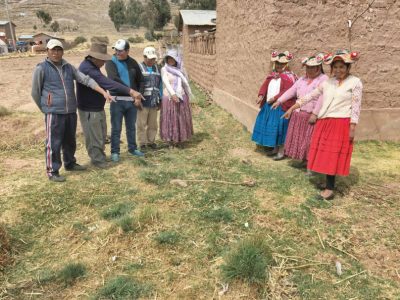
Summary:
Permagardens and the Terra Firma Method can enhance climate resilience, landscape management, and family nutritional security and empowerment anywhere in the world, including in the highland tropical climate of the Lake Titicaca region. All actions during these three community-based trainings will follow the Rule of CLOSE (close, local, organic, small and easy) to facilitate positive attitudes and acceptance. Positive mind and body connections with the earth will be built so that the community participants (15 men and women will participate in each of the 3-day Terra Firma trainings) can make proper choices as to how they wish to proceed; be it vegetable gardens or alpaca rangeland management. Training will be in support of Asociación Pro-DIA, the implementation body of the Chijnaya Foundation.
While Sustainability is the vision, Resilience is the goal. Terra Firma will provide critical objectives and tasks that lie ahead to attain both. The focus will fall initially upon the water capture and management opportunities within the ‘soon to be improved’ healthy soils around homes. From these small protected spaces, the Terra Firma Method can guide families towards weekly harvesting of grain, legume and fodder, potentially even through the lean months. The method will also guide grassland and alpaca water management choices as participants desire. Further ecological guidance will be provided to Asociación Pro-DIA water engineers as they develop plans for spring-fed water catchment systems in the remote highlands. Trees, shrubs, grasses and swales will be designed so as to enhance spring development longevity and resilience.
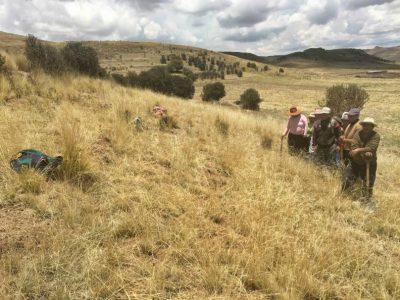 Challenges of the Altiplano Regions including Lake Titicaca:
Challenges of the Altiplano Regions including Lake Titicaca:
o Cold nights + intense UV daylight leads to high evaporation, crop ‘burning’/stunting.
o Cool to cold daytime temperatures limit the growth of most vegetable crops.
o Soil moisture-holding ability is limited due to low organic matter additions.
o High demand for livestock fodder and manure as fuel limits organic matter for soil building.
o High demand for livestock fodder grasses combined with low moisture-holding soils creates fodder shortages and poor livestock nutrition.
o High wind and potential frost damage throughout the year.
o High rates of low childhood nutrition due to lack of daily nutrient-dense complementary feeding access.
o Each of these can be addressed via the Terra Firma Method.
o The training will be held in three locations as directed by Asociación Pro-DIA staff: Ccotos, Pucachupa, and Colquejahua. 15 men and women will meet in each location to determine where and when each short-duration, high-impact training will take place.
Beneficiaries
It is anticipated that each of the 45 people trained will proceed to train 10 others when they return to their communities, yielding a total of 450 people who will benefit from the project.
Conclusion of Altiplano Agroecological Training – Peru
This project has been completed under the direction of Peter Jensen, Agroecology and Permagarden Training Specialist. To read about the start of the project, CLICK HERE.
Each of these challenges, to a large degree, can be met via the Terra Firma Methodology of assessing, capture, protect, produce, manage and repeat. It is the process of decision making that is paramount, leading to the individual choice of final product, be it garden, pasture, crop field or watershed spring protection.
Over the course of 3 weeks, 5 community groups in 3 districts participated in 3-day Terra Firma Climate mitigation and adaptation trainings. These leaders will now take what they have learned and be able to make proper choices as to how they wish to proceed; be it vegetable gardens or alpaca rangeland management, or larger efforts to protect fragile highland watersheds with swales and berms and ecologically appropriate landscape plantings. All community-level Training was held in support of PRO-Dia, the implementation body of the Chijnaya Foundation.
While sustainability is always the vision, it is important to note that this is extremely difficult to accurately measure. Therefore, Resilience is the goal. The Terra Firma method provides the critical objectives and tasks that lie ahead to attain both. Focus fell initially upon the water capture and management opportunities within the ‘soon to be improved’ healthy soils around homes. From these small protected spaces, the Terra Firma Method can guide families towards weekly harvesting of grain, legume, and fodder, potentially even through the lean months. The method was also used to guide grassland and alpaca water management choices as participants desired. Based upon these lessons learned, further ecological guidance will be provided to Asociación Pro-DIA collaborating water engineers as they develop plans for spring-fed water catchment systems in the remote highlands. Trees, shrubs, grasses, and swales will be designed so as to enhance spring development longevity and resilience.
The trainings were held in three locations as directed by Asociación Pro-DIA staff: Ccotos, Pucachupa, and Colquejahua. 15 men and women met in each location to determine where and when each short duration, high impact training took place.
Before Pictures:
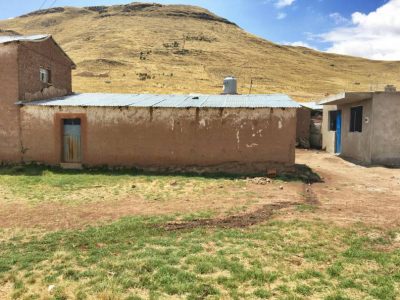
After Pictures:
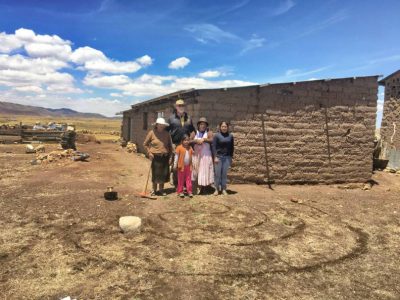
Watershed Spring Development
In the highlands above the Altiplano, alpaca herding families live a life blended with the challenges of the landscape. Access to freshwater and adequate grazing land is an increasingly precarious challenge to overcome due to climate changes. While the same overall amount of precipitation still falls, it is the even more drastic unpredictability of the rain or drought arrivals that leads to water, grazing, and food insecurity. In an effort to counteract this insecurity, Pro-DIA and Chijnaya Foundation are planning to develop spring catchment systems and cisterns. Funding for these cisterns also comes from Water Charity. To further increase watershed protection, groundwater recharge and overall resilience, Terra Firma provided initial guidance on the creation of catchment swales and grassland stabilization above the spring water seeps. Ongoing guidance will be provided as the projects move forward.
In the photos below, the blue boxes represent the location of the concrete cisterns and containment reservoirs the red contour lines are contour swales to hold and sink the runoff and the green contour lines below are vegetation bunds consisting of strategically replanted native grasses and small shrubs.
Overall, this was an incredible challenge and opportunity for the Terra Firma Method and its environmental resilience goal. Food and Livelihood Security can be achieved in any environment so long as we learn how to read the environment, capitalize on its virtues and mitigate its weaknesses. The process of learning is more important than the teaching of an individual practice. Once these agrarian community leaders understand the Terra Firma ‘process’ they will be able to create their own Terra Firma ‘product’ on their own terms. Whether that product is a Keyhole Permagarden or a modified hillside terrace or a watershed protective living swale, the way to reach that destination is through the journey of the Terra Firma method.
It was my enormous pleasure to provide this initial exposure to agroecological resilience in the Altiplano of Puno Region, Peru. Terra Firma International stands ready to assist and reconnect in the future as the need arises. It is not what you look at that it of the greatest importance; rather, it is what you see. And what we see, is an overwhelming opportunity for lasting resilience.
Integrate these paragraphs into the conclusion report, along with the picture captions.
Ccotos Keyhole: Members of the Ccotos Ecotourism Council show off their completed water retention ‘Keyhole’. This streetside Keyhole took just an hour to create and will serve as an ongoing visual to passers-by.
Ccotos Keyhole Amendment: Using only those organic amendments that are easily and commonly accessible, these local leaders learn how simple and doable these ecological gardens can be created.
Gregorio’s Expanded Keyhole: Gregorio, the owner of a local tourist hostel, and his fellow local leaders expanded a simple keyhole to include two more large curving double dug beds. These beds and berms and initial keyholes will hold all the runoff from the nearby roof and pathways deep within the subsoil reducing the need for dry season irrigation.
Runoff Protection: If a runoff is stopped then it will slowly sink. It is a simple concept using only locally accessible tools and plants.
Watershed Spring: A top-down view of plans for ecological protection. This captured spring will provide a clean safe source of drinking water to 50 highland alpaca herding families in the highland regions of the altiplano for many years to come.
Three more pictures for the after report: These are from Pucachupa.
Family Keyhole to be Expanded: Four generations of women worked together over 2 hours to capture all the runoff from their home roof! As the keyhole shows its value, the remaining curved garden beds will be double dug and amended using the same techniques as in the keyhole bed.
Where the water flows: This clearly shows the water management pathways! If you hold the water in the soil, the soil itself becomes the ‘water tank’.
The spiral: As runoff enters the keyhole, it will literally spin, thereby unlocking the soil’s potential!
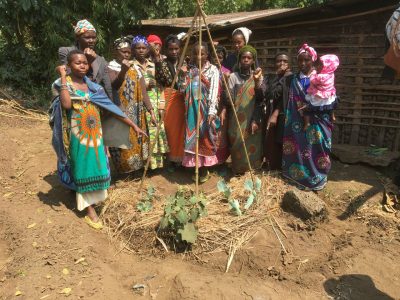 Captured Runoff in Colquejahua: What had once been a site of wastewater lost is now a living community example of wastewater captured. And it took less than 2 hours to design and create this Terra Firma Keyhole.
Captured Runoff in Colquejahua: What had once been a site of wastewater lost is now a living community example of wastewater captured. And it took less than 2 hours to design and create this Terra Firma Keyhole.
Modified Pasture Terrace: This terrace sits below 30-year-old stone terraces. The stone terraces were built under a Peruvian Government program but are not being recreated due to the extreme labor requirement to build them further. This modified pasture terrace will use the Terra Firma technique of water management and only required 2 hours to build. The swale above the double dug bed will prevent runoff while forcing it below the double dug bed. The bed will be planted with oats and alfalfa. The alfalfa-growing below the tall oats will then remain after the oats are harvested.
Simple Swale: Protecting natural water seep in the highlands is essential. This contour swale will stop and sink runoff for many years.
Protected Hillside: Following the easy upper swale creation, this group of community leaders decided to extend the concept further thereby protecting this entire section of fragile hillside.